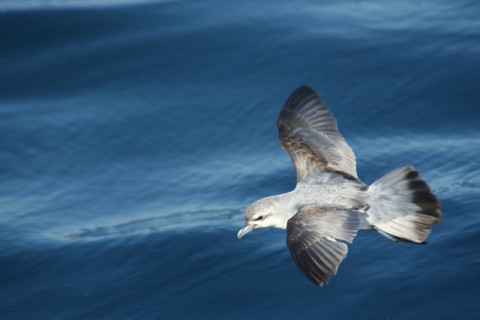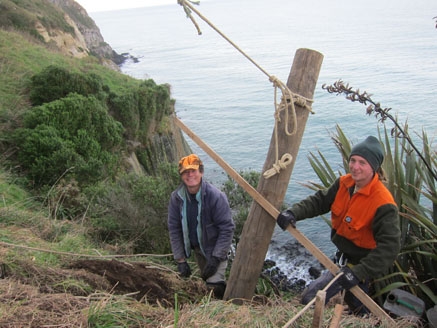Fencing fairies
Blogger: Forest & Bird member, Jeremy Beck
“Do you feel comfortable here?” Graeme asked, as we began scaling the hillside with a rope—a frothy sea churning below us.
Despite secretly answering “no” to this question, I spent four days volunteering with Forest & Bird member Graeme Loh and others along the 70-meter sea cliffs at St. Clair, Otago.
The mission: to enable Fairy Prions to recolonize the cliff top by erecting a predator-proof fence.
New Zealand is Fairy Prion capital of the world with around 50% of the world’s population residing here.
Their stronghold is the Marlborough sounds, however colonies can be found dotted around the country including Poor Knights, Banks Peninsula, the Chathams, Snares and the Antipodes islands.
Their high rise home on the Otago peninsula is the only known breeding colony on the mainland and looking at the spot you can see why – it’s completely inacessible to predators.
Graeme accidentally discovered this prion nest site nearly twenty years ago, and he’s been carefully studying the birds ever since—even attaching his own data loggers to their legs to help track their habits.
He’s also given the 200 nesting pairs a choice of homes: either a DIY cliff face digout, or one of his nesting boxes. So far, eighty pairs have chosen this second option.
Reaching the birds involves abseiling down the cliff face to their nests, which Graeme performs regularly—but when he offered to lower me down for a peek, I politely declined.
Determining that a fence could do much to expand safe nesting space, Graeme secured funding for the project from Forest & Bird Dunedin and collected a group of workers and volunteers to complete the task.
Positioned on the steep paddock adjacent the cliffs, we organized bags of concrete mix, containers of water, and piles of fence posts, and then shuttled the supplies downhill using a flying fox system Graeme had devised.
During our lunch break, we enjoyed watching Buller’s mollymawks, sooty shearwaters, black-backed gulls, gannets, and giant petrels soar along the coast. On one occasion, volunteers also observed a pod of bottlenose dolphins passing below.
Though not critically endangered, local conservationists would like to enhance the fairy prion population in the Dunedin area. They also hope the population of titi (sooty shearwater) nesting nearby will take advantage of the new safe zone. With the last fence posts erected last Tuesday, the site now awaits the arrival of mesh fencing to finish off the job.
See the recent ODT stories on this project:
http://www.odt.co.nz/news/dunedin/167883/kiwi-ingenuity-and-steady-nerves-help-fairy-prions
http://www.odt.co.nz/news/dunedin/167883/kiwi-ingenuity-and-steady-nerves-help-fairy-prions
Watch this video on the construction of the fence –


